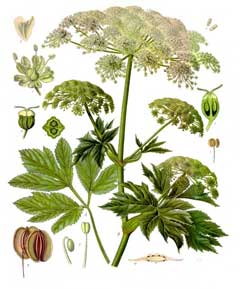 |
|
http://commons.wikimedia.org/wiki/File:Koeh-236.jpg |
 |
| http://commons.wikimedia.org/wiki/User:Hedwig_Storch |
Translate this page:
Summary
Physical Characteristics

 Peucedanum ostruthium is a PERENNIAL growing to 1.2 m (4ft).
Peucedanum ostruthium is a PERENNIAL growing to 1.2 m (4ft).
See above for USDA hardiness. It is hardy to UK zone 5 and is not frost tender. It is in flower from June to August. The species is hermaphrodite (has both male and female organs) and is pollinated by Insects. The plant is self-fertile.
Suitable for: light (sandy), medium (loamy) and heavy (clay) soils. Suitable pH: mildly acid, neutral and basic (mildly alkaline) soils. It can grow in semi-shade (light woodland) or no shade. It prefers moist soil.
UK Hardiness Map
US Hardiness Map
Synonyms
Imperatoria ostruthium. L.
Plant Habitats
Woodland Garden Sunny Edge; Dappled Shade; Shady Edge; Meadow;
Edible Uses
Edible Parts: Leaves
Edible Uses: Condiment
Leaves - cooked[2, 115, 177]. Used as a potherb or as a flavouring[61, 183]. The aromatic roots can be used as a flavouring[183]. They are said to taste hotter than pepper[4]. A particularly popular drink is made from the fermented roots[7].
References More on Edible Uses
Medicinal Uses
Plants For A Future can not take any responsibility for any adverse effects from the use of plants. Always seek advice from a professional before using a plant medicinally.
Antispasmodic Aromatic Bitter Carminative Diaphoretic Digestive Diuretic Emmenagogue
Expectorant Febrifuge Homeopathy Odontalgic Skin Stimulant Stomachic
Masterwort is little used in modern herbalism, but it may well be a herb that bears further investigation[254]. It was held in high regard in the Middle Ages where it was especially valued for its ability to resolve all flatulence in the body and stimulate the flow of urine and menstruation[254]. It was also used in treating rheumatic conditions, shortness of breath, kidney and bladder stones, water retention and wounds[254]. The root is antispasmodic, aromatic, bitter, strongly carminative, diaphoretic, digestive, diuretic, emmenagogue, expectorant, febrifuge, stimulant and stomachic[4, 7, 9, 21, 254]. It is of use in the treatment of asthma, dyspepsia and menstrual complaints[4], an infusion helps to relieve migraine[7]. The root is gathered in the spring or autumn and dried for later use[7, 9]. An essential oil from the plant has a euphoric and odontalgic effect[7]. Used externally, it relieves skin irritation[7]. When used externally, the plant or the extracted essential oil can cause an allergic reaction to sunlight[254]. A homeopathic remedy is made from the roots[9]. No details of its applications are given[K].
References More on Medicinal Uses
The Bookshop: Edible Plant Books
Our Latest books on Perennial Plants For Food Forests and Permaculture Gardens in paperback or digital formats.

Edible Tropical Plants
Food Forest Plants for Hotter Conditions: 250+ Plants For Tropical Food Forests & Permaculture Gardens.
More

Edible Temperate Plants
Plants for Your Food Forest: 500 Plants for Temperate Food Forests & Permaculture Gardens.
More

More Books
PFAF have eight books available in paperback and digital formats. Browse the shop for more information.
Shop Now
Other Uses
References More on Other Uses
Cultivation details
An easily grown plant, it succeeds in any moisture-retentive soil in a sunny position[200]. Dislikes shade. This report contradicts the report that this plant grows wild in woodlands. Masterwort was at one time cultivated as a pot herb and for medicinal purposes, though it has now fallen into virtual disuse[4, 200]. Suitable for group plantings in the wild garden[200].
References Carbon Farming Information and Carbon Sequestration Information
Temperature Converter
Type a value in the Celsius field to convert the value to Fahrenheit:
Fahrenheit:
The PFAF Bookshop
Plants For A Future have a number of books available in paperback and digital form. Book titles include Edible Plants, Edible Perennials, Edible Trees,Edible Shrubs, Woodland Gardening, and Temperate Food Forest Plants. Our new book is Food Forest Plants For Hotter Conditions (Tropical and Sub-Tropical).
Shop Now
Plant Propagation
Seed - we have no information on this species but suggest sowing the seed in a cold frame as soon as it is ripe if this is possible otherwise in early spring. When they are large enough to handle, prick the seedlings out into individual pots and plant them out in the summer.
Other Names
If available other names are mentioned here
Native Range
EUROPE: Austria, Switzerland, Czech Republic, Germany, Poland, Ukraine (incl. Krym), Italy, Romania, Slovenia, Spain, France (incl. Corsica)
Weed Potential
Right plant wrong place. We are currently updating this section.
Please note that a plant may be invasive in one area but may not in your area so it's worth checking.
Conservation Status
IUCN Red List of Threatened Plants Status :

Growth: S = slow M = medium F = fast. Soil: L = light (sandy) M = medium H = heavy (clay). pH: A = acid N = neutral B = basic (alkaline). Shade: F = full shade S = semi-shade N = no shade. Moisture: D = dry M = Moist We = wet Wa = water.
Now available:
Food Forest Plants for Mediterranean Conditions
350+ Perennial Plants For Mediterranean and Drier Food Forests and Permaculture Gardens.
[Paperback and eBook]
This is the third in Plants For A Future's series of plant guides for food forests tailored to
specific climate zones. Following volumes on temperate and tropical ecosystems, this book focuses
on species suited to Mediterranean conditions—regions with hot, dry summers and cool, wet winters,
often facing the added challenge of climate change.
Read More
Expert comment
Author
(L.)Koch.
Botanical References
1750200
Links / References
For a list of references used on this page please go here
Readers comment